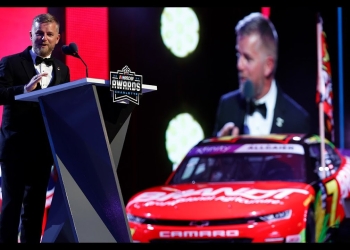The Birth of NASCAR's Most Daring Track: Talladega
Talladega Superspeedway, originally known as Alabama International Motor Speedway, holds a special place in NASCAR history. This iconic track, born in 1969, quickly earned a reputation as the fastest and most challenging circuit in stock car racing. Let's dive into the story of how Talladega became NASCAR's baddest track, as told by racing legend Richard Petty.
A Need for Speed
When Talladega first opened its gates, it was billed as the "world's fastest and safest closed-course race track." The 2.66-mile tri-oval boasted steep banking and long straightaways that allowed cars to reach unprecedented speeds. However, this pursuit of velocity would soon reveal an unforeseen challenge.
"We averaged 199, almost 200 miles per hour for an average speed," recalls Richard Petty, highlighting the incredible pace achieved at Talladega.
The Tire Dilemma
The track's extraordinary speed quickly exposed a critical issue: tire failure. At the time, NASCAR cars ran on treaded tires with substantial rubber compounds. While these tires performed well on other tracks, Talladega's extreme conditions proved too much for them to handle.
The Root of the Problem
- High speeds
- Excessive heat generation
- Rapid rubber degradation
Petty explains, "They finally figured out that by having the treaded tire plus having so much rubber, as the momentum went, the rubber would just go away. It couldn't keep up with the tire."
This problem became evident during practice sessions, where drivers experienced alarming tire wear after just a few laps. "Four or five laps and just throw them, throw them clean off," Petty recalls.
Safety Concerns and Driver Rebellion
The tire issues at Talladega weren't just a performance problem – they posed a serious safety risk. Recognizing the danger, the drivers took a stand.
"All the drivers and stuff got together and said we're not going to do this. I mean, we risk our life enough, but when we know we got a problem, then we're not going to do it," Petty remembers.
This united front from the drivers forced NASCAR and tire manufacturer Goodyear to address the issue seriously.
Click here to preview your posts with PRO themes ››
A Week of Challenges and Innovation
The week leading up to Talladega's inaugural race became a frantic period of problem-solving and adaptation. Goodyear worked tirelessly to develop a solution, bringing new tire compounds to the track each day.
| Day | Action |
|---|---|
| Tuesday-Wednesday | Initial practice sessions reveal tire problems |
| Thursday-Saturday | Daily tire compound changes and testing |
| Sunday | Scheduled race day (postponed) |
"Every morning we'd have a new set of tires. They'd try down," Petty explains, describing the constant cycle of testing and refinement.
The Silver Lining: Unprecedented Publicity
While the tire saga presented significant challenges, it inadvertently provided Talladega with an enormous amount of publicity. The drama surrounding the new track captured national attention, much like the delays that had occurred at Daytona years earlier.
Petty draws the parallel: "Same thing with Daytona, the first race. Bill France probably knew my dad and won the race, but he put it off three days, got all that free publicity. All of a sudden, everybody knows Daytona."
Legacy of the 'Big Bad Track'
The tire controversy and subsequent race postponement at Talladega created a media frenzy that put the track on the map. "It was a bad week from one standpoint, but it made so much news that everybody in the country knew about Talladega," Petty reflects.
This notoriety helped cement Talladega's place in NASCAR lore. The track's reputation for high speeds, intense racing, and unpredictable outcomes continues to this day, making it a favorite among fans and a true test of skill for drivers.
The Talladega Experience
Today, Talladega Superspeedway remains one of the most exciting and challenging tracks on the NASCAR circuit. Its unique characteristics include:
- 33-degree banking in the turns
- 2.66-mile tri-oval layout
- Speeds often exceeding 200 mph
- Famous for multi-car crashes known as "The Big One"
Click here to preview your posts with PRO themes ››
Fans flock to Talladega twice a year for NASCAR Cup Series races, eager to witness the heart-pounding action and unpredictable finishes that have become the track's trademark.
Conclusion
The birth of Talladega Superspeedway may have been marked by controversy, but it ultimately led to the creation of one of NASCAR's most iconic venues. Through the challenges of those early days, the track forged its identity as the fastest and most daring circuit in stock car racing. As Richard Petty's recollections show, sometimes the biggest obstacles lead to the most legendary outcomes in motorsports history.









